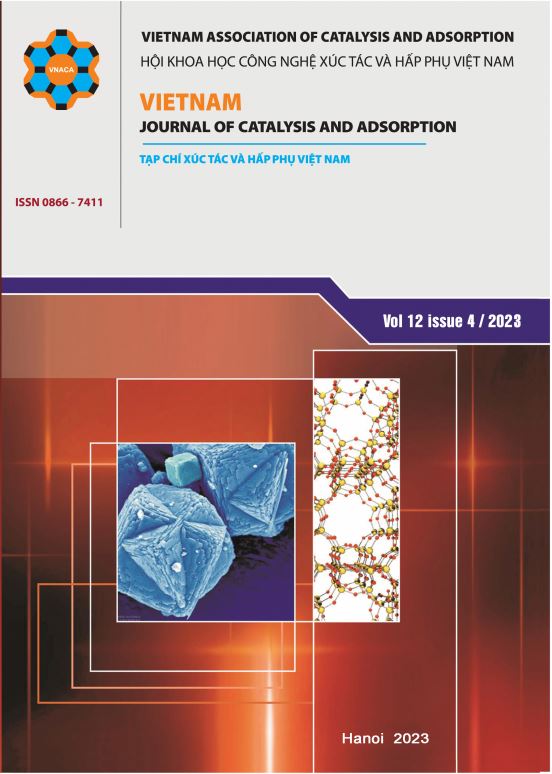A novel adsorbent based electroplating sludge – rice husk char for removal of methylene blue and ciprofloxacin in aqueous solution
DOI:
https://doi.org/10.62239/jca.2023.069Keywords:
Electroplating sludge, rice husk char, methylene blue, ciprofloxacinAbstract
The adsorbent based electroplating sludge and rice husk char (CR) was prepared by ultrasonication method for adsorption of methylene blue (MB) and Ciprofloxacin (CIP) in water. The characteristics of adsorbent such as surface morphology, specific surface area, functional groups, element components was confirmed by SEM, BET, FT-IR, XRD and EDX. The results showed the adsorbent is porous structure with BET surface area of 175.22 m2/g, most of pore width belonged meso section. Removal effectiveness of MB and CIP were 99.89% and 74.96%, respectively after 90 min of adsorption. The experiment was implemented with the mockup model containing of methylene blue and ciprofloxacin in NH3.
Downloads
References
L.T.Q. Lien, N.Q. Hoa, N.T.K. Chuc, N.T.M. Thoa, H.D. Phuc, V. Diwan, N.T. Dat, A.J Tamhankar, C. S. Lundborg, International Journal of Environmental Research and Public Health 13(6) (2016) 588. https://doi.org/10.3390/ijerph13060588.
C. R. B. Gama, M. A. G. Pombo, C.P. Nunes, G. F. Gama, S. GE Mezitis, M. S. Neto, O. R. Guimarães, M. Geller, L. Oliveira, A. de S. da Fonseca, A. Sitnoveter, G. Goldwasser, K. S. Cunha, L. G. D. Junior, Research and Reports in Urology 12 (2020) 639-649. https://doi.org/10.2147/RRU.S279060.
Erbelding, E.J. and T.C. Quinn, Dermatologic clinics 16(4) (1998) 735-738. https://doi.org/10.1016/S0733-8635(05)70039-5.
T.T.K. Phuong. and D.T.V. Ha. Tạp chí Y học Việt Nam 518(2) (2022).
N.T. Nhung, L.T. Binh. Tạp chí Y học Việt Nam 508(2) (2021).
G. Bonkat, R. Bartoletti, F. Bruyère, T. Cai, S.E. Geerlings, B. Köves, S. Schubert, F. Wagenlehner, Arnhem: European Association of Urology, 2018.
P.T. Thuy, N.L. Chi, N.T. Linh, N.T. Hanh, N,M. Khai, Kỷ yếu Hội nghị: Nghiên cứu cơ bản trong “Khoa học Trái đất và Môi trường 2019 700-703. https://10.15625/vap.2019.000238.
T.Yem, N.T.Ha., T.V. Quy, N. M. Khai. Tạp chí Khoa học ĐHQGHN, Khoa học Tự nhiên và Công nghệ 24 (2008) 228-235.
T. V. Quy, T.Yem, N. T.Hà, N. M. Khải. Tạp chí Khoa học ĐHQGHN, Khoa học Tự nhiên và Công nghệ 24 (2008) 145-150.
N.M. Khai, N.V. Anh, H.T. Hai, N.H. Hao, Environmental Science and Pollution Research 29(28) (2022) 41873-41874. https://doi.org/10.1007/s11356-022-20200-6.
R. M. Obodo, S. M. Mbam, D. C. Iwueke, M. Ramzan, R. Ijeh, I. Ahmad, M. Maaza, F. I. Ezema. Energy Storage 4(5) (2022) 347. https://doi.org/10.1002/est2.347.
C.Tokoro, S. Suzuki,D.e Haraguchi, and S. Izawa. Materials 7(2) (2014) 1084-1096. https://doi.org/10.3390/ma7021084.
T.Q. Toan, T.K. Ngan, D.T. Huong, P.-A. Le, N.T. Thuy, N.N. Huy, D.V. Thanh, N.M. Khai, N.T. Mai, ACS omega 8 (11) (2023) 9904–9918. https://doi.org/10.1021/acsomega.2c07034
T.H. Tran, Q.M. Tran, T.V. Le, T.T. Pham, V.T. Le and M.K. Nguyen. Heliyon 7(5) (2021) e07092. https://doi.org/10.1016/j.heliyon.2021.e07092
H.X. Qiao, Z.Q. Wei, H. Yang, L. Zhu, X.Y. Yan. Journal of Nanomater 2009 (2009) 1-5.
T. T. M. Huong, T.H. Con, T.T. Dung. VNU Journal of Science: Earth and Environmental Sciences 33(1) (2017) 26-35.










